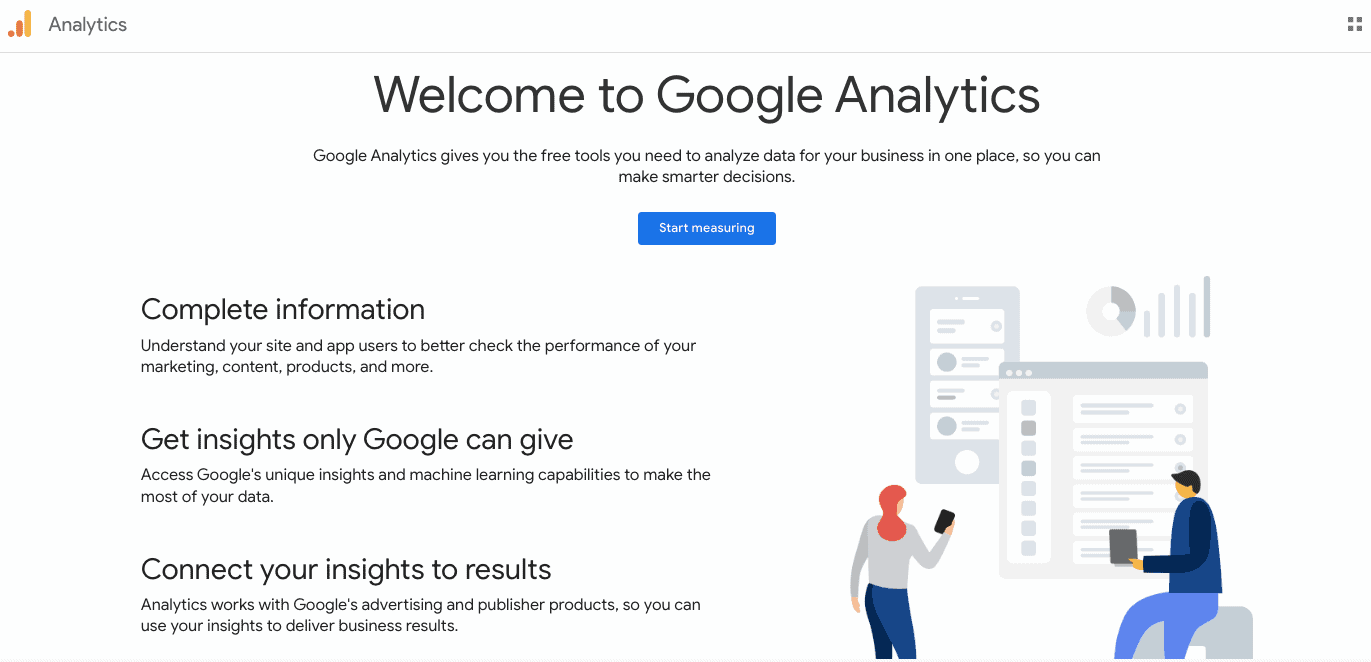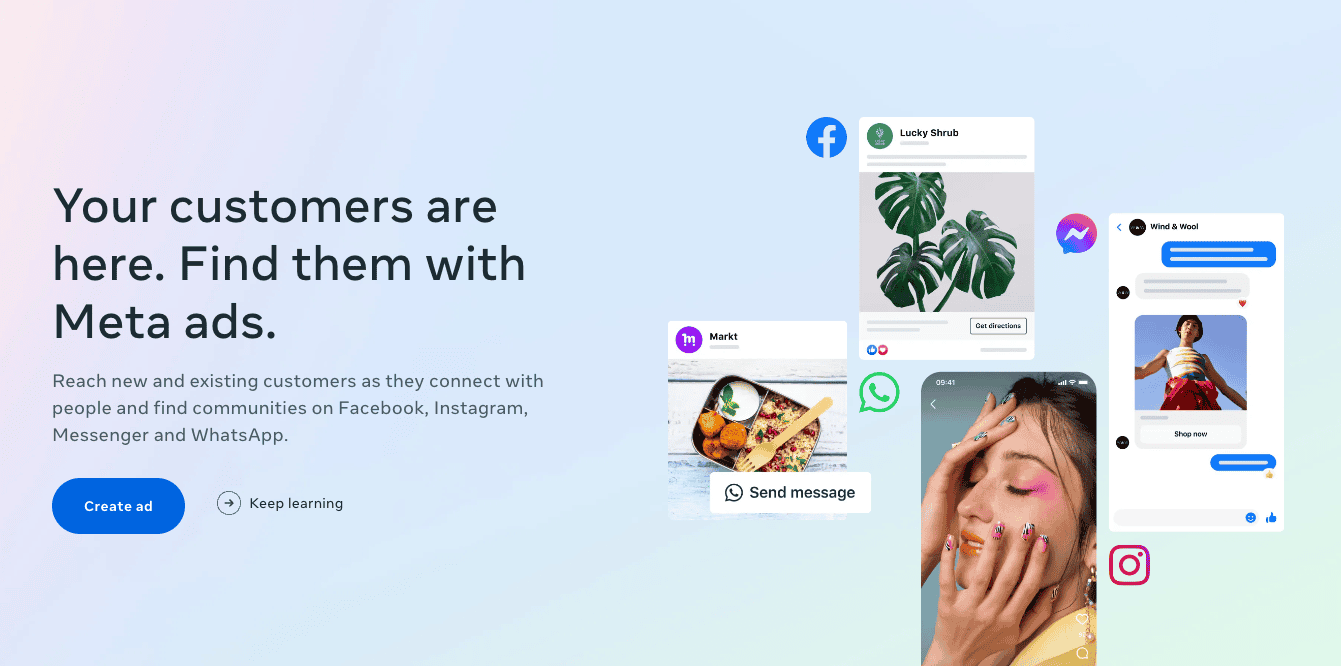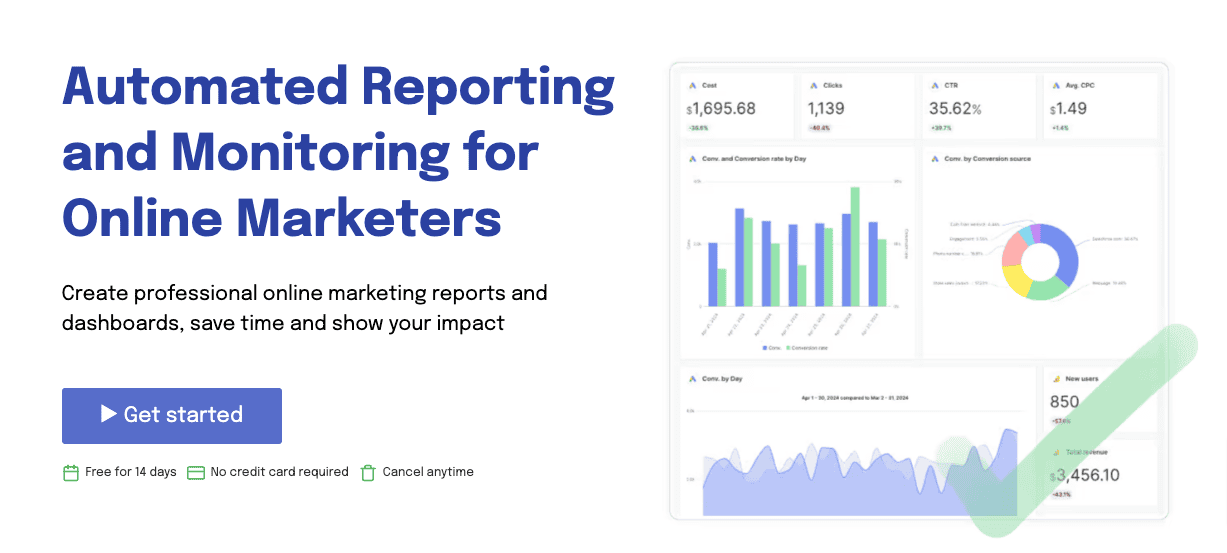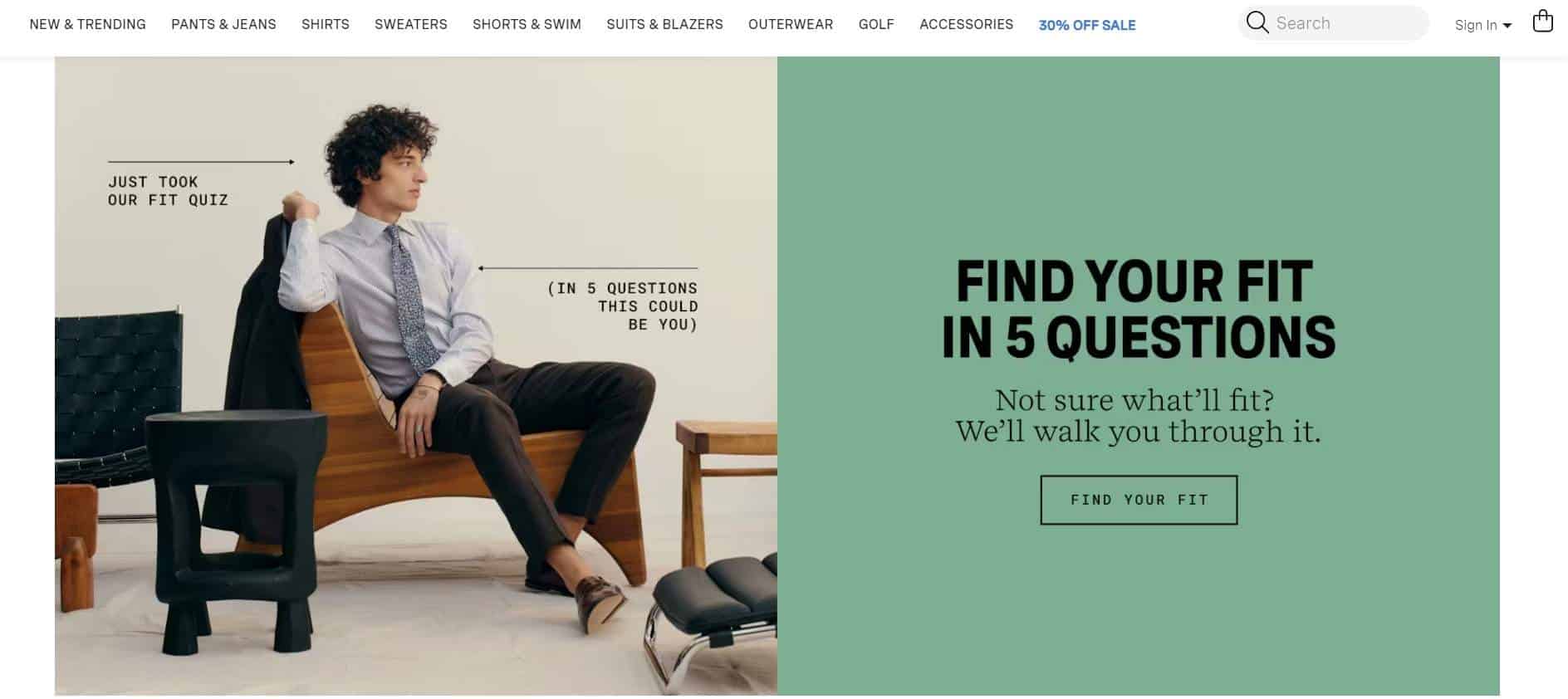Return on ad spend or ROAS is a key performance indicator that requires you first to divide the money gained through advertising over the money spent. Next, multiply that sum by 100.
Yep, that’s about it!
The goal of calculating ROAS is to help you determine if your business ad spending drives a profit or if you’re sinking into the red. It’s a crucial metric to measure no matter your business size, but it is especially valuable for startups and small businesses.
After all, every dollar spent is critical at that stage.
Even in 2025, as the marketing business continues to change due to technology, ROAS remains unaffected. It’s as important of a marketing metric as ever, especially in your quest to optimize your investments in advertising and marketing.
In this blog post, we’ll discuss what return on ad spend is, how to calculate it, how to make sense of your results, and tips to make your ad campaigns more cost-effective.
Let’s get started!
Table of Contents
Key Takeaways
- Return on ad spend, or ROAS, is a measurement that determines how profitable your ad campaigns are.
- You can calculate ROAS by dividing your ad profit by your ad spend and multiplying by 100. Return on ad spend is sometimes expressed as a percentage, other times as a ratio, and other times as a dollar amount.
- Optimizing your landing pages, identifying all the sources of spending, and using tracking tools will help you improve your ROAS.
What is Return on Ad Spend (ROAS)?
Return on ad spend, or ROAS, is a marketing metric that measures the amount of revenue earned for every dollar spent on a marketing campaign.
How do you calculate ROAS?
Let’s dive deeper.
ROAS formula
Calculating ROAS is easy. Here’s the formula for you:
ROAS = (Revenue from ads ÷ ad spend) × 100
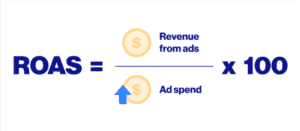
Let’s break that down in a little bit more detail. You can gauge your return on ad spend by dividing it by two numbers. First, calculate your ad revenue, then divide that by what you’ve spent on ads.
Next, all you have to do is multiply that number by 100. Easy.
How about I use an example to show you ROAS in action? Let’s say you spent $1,000 on your last ad campaign. You generated $650 in profits.
So, you’d divide 650 by 1,000, which gives you 0.65. Multiply that by 100, and you get 65. That’s 65%.
You have other ways to express ROAS. For instance, you can do so as a ratio, like 3:1, with the 3 representing $3 in revenue and the 1 standing for $1 spent on ads. Or you can divide your ad revenue by your ad spend and not multiply it by 100. That will give you ROAS in a dollar amount.
ROAS benchmarks
Okay, so you’ve calculated your ROAS. Now what?
As a standalone number, it’s hard to put any value on it. That’s why you need benchmarks against which to compare your results.
Here’s a table that will give you just that.
| Industry | Standard ROAS |
| Legal | 150% |
| Technology | 190% |
| Education | 240% |
| Travel | 380% |
| eCommerce | 450% |
By the way, the type of ad platform you use can also influence your target ROAS. For example, a standard ROAS to expect is around $2.50 if you use Google Ads. As I’m sure you can guess, that’s fairly low.
You can get more bang for your buck if you advertise on Facebook. There, the ROAS rate is between $4 and $6.
Read also: eCommerce Metrics Made Easy — How to Measure Success and Drive Growth
ROAS vs ROI
At first glance, it’s easy to conflate ROAS with ROI. They’re both related to advertising and marketing and track what you earn. However, they are not the same.
ROI, short for return on investment, measures what you earned in your campaign against what you spent. It differs from ROAS in several key ways. Let’s take a look.
Costs considered
ROAS only measures what you spend on advertising costs and its relation to what you earn. It’s advertising-centric, whereas ROI can also encompass sales and marketing. It incorporates other expenses into the calculation, including tools and people.
Revenue vs profit
ROAS is a revenue measure that determines what you earn from your ad campaigns. ROI doesn’t only look at revenue but overall broader business profitability. That’s why you should calculate ROI when you want to know how profitable your business is.
On the other hand, you’d only calculate return on ad spend to learn how profitable your ad campaigns are.
What it measures
ROAS concerns itself with individual ad campaigns, whereas ROI paints a picture of an entire investment.
Rather than thinking about ROI and ROAS as using one over the other, use them to determine how much your business earns overall.
Read more: How to Maximize ROI with Strategic Product Placement
How to Calculate ROAS
ROAS is a simple enough calculation, but I want to help you make heads or tails of your results. So, let’s go deeper into return on ad spend and how and what to calculate.
How to determine revenue attribution
There are two revenue attribution models associated with tracking ROAS. One is a single-touch model, and the other is multi-touch.
Allow me to explain. Single-touch attribution credits one of two touchpoints before conversion, either the first or last. Crediting the first touchpoint means it only took one ad interaction for the customer to convert. Not impossible, of course, but not easy, either.
Last-touch attribution means that it took several ads to convert the customer and that the most recent one (i.e., the last one) they saw finally converted them.
Okay, so that’s single-touch attribution. Then, there’s the multi-touch attribution model. Of the two, this is deemed to be the most accurate.
As “multi-touch” might make you think, this attribution model considers every touchpoint from lead to customer. That includes every advertising channel, from PPC to social media.
Ad platforms such as Google Ads make it easy to track multi-touch attributions without having to do so manually. Talk about convenience!
How to calculate costs
While ROI is a more encompassing revenue attribution calculation for measuring costs, ROAS can do it too. You just have to include the right factors in your calculation.
I’m talking about affiliate commissions, impressions and clicks, vendor fees, labor, and ad spending. Why don’t I break it down point by point and explain?
- Affiliate commissions: The commission fees must go into your ROAS calculation if you work with influencers or affiliate marketers.
- Impressions and clicks: Have you run cost-per-thousand or cost-per-click ads? CPT relies on passive ad impressions, while CPC ads charge by the number of clicks. You must account for both expenses when you return on ad spend.
- Vendor fees: Any third parties your business relies on in your quest to grow through paid ads must also be accounted for when calculating ROAS.
- Ad spend: Then, of course, there’s your ad spending costs, the standard ROAS measurement.
How to use tracking tools
The right tools can further your ad campaigns, as you can get more valuable metrics. You’re in the middle of running an ad campaign, so don’t stress about researching tools. I’ve got some five-star recommendations here.
Google Analytics
First, I’ll start with the old standard, the tool that more than 30 million websites rely on to stay competitive. I’m talking about Google Analytics, of course.
You need Google Analytics 4 to make the most of your ROAS reports. Go to Advertising, then Performance, and choose All channels to see the latest data.
You can break down your paid marketing channels by criteria like ROAS, total revenue, cost per conversion, ad cost, and conversions.
You can adjust the attribution model by going into Admin, Property, and Attribution Settings.
OWOX BI
Known for its data democratization services, OWOX BI is a data enablement tool for businesses and teams that sift through large quantities of data. It promises even more detailed ROAS insights than Google Analytics 4, which says something!
OWOX BI can centralize raw ad cost data, read exported data from Google Analytics 4 and other sources, and provide overviews of your return on ad spend. Based on the GA4 information, you can set up custom visualizations or funnel dashboards in OWOX BI.
Facebook Ads
I’m pretty sure Facebook and its ad platform need no introduction. It uses ROAS to measure website purchases. In other words, how many purchase events are generated by the Conversions API or Meta Pixel on your site associated with your ads?
Return on ad spend on Facebook is calculated this way: your site purchases conversion rate divided by the amount you spent on advertising.
Facebook notes that it sometimes relies on statistical modeling and that missing and partial data can occur when calculating ROAS on the platform, which is something to be aware of.
Swydo
The automated monitoring and reporting tool Swydo measures ROAS and goals completed, transactions, and pageviews with pre-built reports. It integrates with Google Analytics 4 and other analytics tools.
Read more: How To Handle Dropshipping Returns and Refunds
5 Strategies to Improve ROAS
Did you calculate your ROAS and were disappointed in the results? It happens, especially for your first campaign.
That said, this is why you track return on ad spend. Without reviewing it, you’d never realize whether you’re spending too much on your ad campaigns.
Fortunately, you have options if you want to elevate your ROAS. Here are some of the top strategies to implement.
1. Optimize ad spend
First, it’s time to examine your advertising campaign critically. Review which ads have performed the best and those that have brought down your entire campaign.
Those ads that are underperforming are worth revising. For example, you may need to retool the ad message or target another audience segment. I would only recommend this if your underperforming ads aren’t expensive.
The ones that cost you the most and perform the worst have got to go.
Leave the high-performing ads, of course, but study them closely to understand why they’ve done well. Can you replicate their success across your other ads?
Now is also an excellent time to reallocate your budget. Strip back the spending on those high-cost, low-performing ads and funnel the expenses toward other ads that could use more financial backing.
2. Refine audience targeting
You should have segmented your audience before your first ad campaign, but did you know tools like Facebook Ads can take segmentation further? You can create Lookalike and Custom Audiences on Facebook.
A Custom Audience uses Meta tech to amalgamate a unique audience group. What’s cool about Custom Audiences is that you don’t exclusively have to use your Facebook presence to compile them.
For example, Facebook can pull from your shop engagement, video engagement, Instagram engagement, Facebook Page engagement, lead forms, instant experiences, customer lists, and website.
Better yet, you can have 500 Custom Audiences on your Facebook account so that this feature can live on across many of your ad campaigns.
Okay, so let’s now look at Lookalike Audiences on Facebook. These audiences can spread your business via Facebook to potentially interested leads akin to your current audience.
Besides those audience targeting strategies, you can also rely on exclusion targeting. This rule allows you to choose who doesn’t see your ads. You can tailor the exclusions to topics, keywords, locations, and preset audiences.
For example, customers who recently converted don’t need to see ads geared toward leads. You could also exclude customers whose product you’re promoting is out of their price range.
3. Enhance your landing pages
Your ads can’t do all the heavy lifting. If your landing pages aren’t designed to convert, then you aren’t going to, simple as that. As good as your ads are, they are only part of the equation.
It’s like that old saying: you can bring a horse to water, but you can’t make it drink. Your ads bring the horse to water, and your landing pages must make them drink.
Here are some strategies to make it happen:
- Perform keyword research to understand the types of search terms your audience seeks when they seek products like yours.
- Follow SEO best practices. Incorporate your keywords into your landing page title, metadata, URL, and body copy.
- Add visual media such as images and videos that underscore your points and add visual appeal to the landing page.
- Design your landing page with plenty of whitespace. That’s the open space around the parts of your page. You need to let the elements breathe to create an attractive design.
- Put your call to action above the fold.
- Cut down on your page loading time.
- Optimize your landing page for mobile.
- Include your value proposition, ideally in your headline, to reduce the bounce rate.
- Add trust seals, testimonials, reviews, and other forms of social proof.
- Simplify your landing page layouts.
- Create individual landing pages for each product or service you sell.
- Use A/B testing on your landing pages before they go live.
4. Automate bidding
Bidding on ad campaigns just got smarter. Today, tools such as Facebook Ads and Google Ads can automate bidding for you using the power of AI. Rather than agonizing and second-guessing every bidding decision you make, you can rest easily knowing the bidding decisions are made using the power of machine learning.
5. Always test and optimize
You should use A/B testing for more than your landing pages; it should also be used for every ad element. Test the various creatives, ad placements, and formats among similar audiences. You never know; sometimes, making a minor tweak is all your ad needs to reach a much larger group of potential customers.
Bear in mind that A/B testing should occur with every campaign. Be ready to learn from your other KPIs besides ROAS, optimizing your ads for more efficient performance.
Read also: What is Cost Per Action (CPA)? Benefits, Challenges, and Tips
2 Real-World Examples to Inspire You
Before wrapping up, how about some handy real-life examples of businesses that prioritized their return on ad spend and generated big results? I hope these inspire you as much as they did me.
Case study 1: Bonobos
The apparel company Bonobos specializes in men’s accessories and outfits. The company is valued at $300 million, which is no small feat for a business that’s not even 20 years old.
Its case study is fascinating. Bonobos had a two-pronged goal. First, it wanted to maintain its high ROAS while acquiring new customers.
So, Bonobos decided to take to Facebook, using its Lookalike Audiences feature to find like-minded users who could become part of its customer base.
Next, Bonobos did some audience segmentation, using Customer Lifetime Value as its yardstick. From there, they produced tailored offers and creative materials for those groups.
The top percent of its lookalike audience produced a return on ad spend rate of 2,000%, which is astounding!
Case study 2: Direct insurance provider
OWOX BI worked with a direct insurance provider to elevate the company’s ROAS with specialized tools. First, the company relied on OWOX BI for data consolidation. After reviewing their numbers, they could see where they were spending on their ads and optimize their spending.
Ultimately, controlling their ad spending allowed the direct insurance provider to elevate its return on ad spend.
Read more: Customer Segmentation Examples & How to Follow Them
Conclusion
Understanding your return on ad spend or ROAS is important to monitor and optimize your advertising campaigns, ensuring they’re cost-effective and yield high returns. Learning and adapting to new tools and strategies will help you stay competitive in the fascinating, evolving advertising landscape.
EngageBay is an all-in-one marketing, sales, and customer support software for small businesses, startups, and solopreneurs. You get email marketing, marketing automation, landing page and email templates, segmentation and personalization, sales pipelines, live chat, and more.
Sign up for free with EngageBay or book a demo with our experts.
Frequently Asked Questions (FAQ)
1. What is return on ad spend (ROAS)?
Return on ad spend or ROAS measures how profitable your advertising is against what you spend on ad campaigns.
2. How do I calculate ROAS for my ad campaigns?
Divide your ad profits by your ad spending, then multiply that number by 100 to calculate the return on ad spend.
3. What is a good ROAS benchmark for my industry?
Since it varies by industry, a good general benchmark is 4:1 or 400%. This will ensure you aren’t losing money by spending on ads.
4. How can I improve my ROAS?
You have plenty of strategies for better return on ad spend, including testing your ads, improving your landing page optimization, automating bidding, targeting your audience more specifically, and reducing spending on low-performing ads.
5. What is the difference between ROAS and ROI?
ROI measures overall campaign profitability, whereas ROAS focuses on how profitable your advertisements are.
6. What costs should I include in my ROAS calculation?
The costs that should factor into your ROAS calculations are affiliate commissions, engagement and clicks, vendor fees, and ad spend.
7. Which attribution model should I use for accurate ROAS tracking?
Multitouch attribution models have been proven more accurate because they account for more touchpoints in the customer journey across multiple platforms.
8. How do automated bidding strategies help improve ROAS?
Automating your bidding can allow you to achieve a higher conversion value.
9. Can I track ROAS across multiple advertising platforms?
You sure can, and in fact, you should. You can gain more insights about your ad spending and make decisions that benefit your business.
10. What tools are available to help me calculate and analyze ROAS?
OWOX BI, Facebook Ads, and Google Analytics 4 are some of the most renowned platforms for uncovering data about your return on ad spend.

